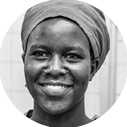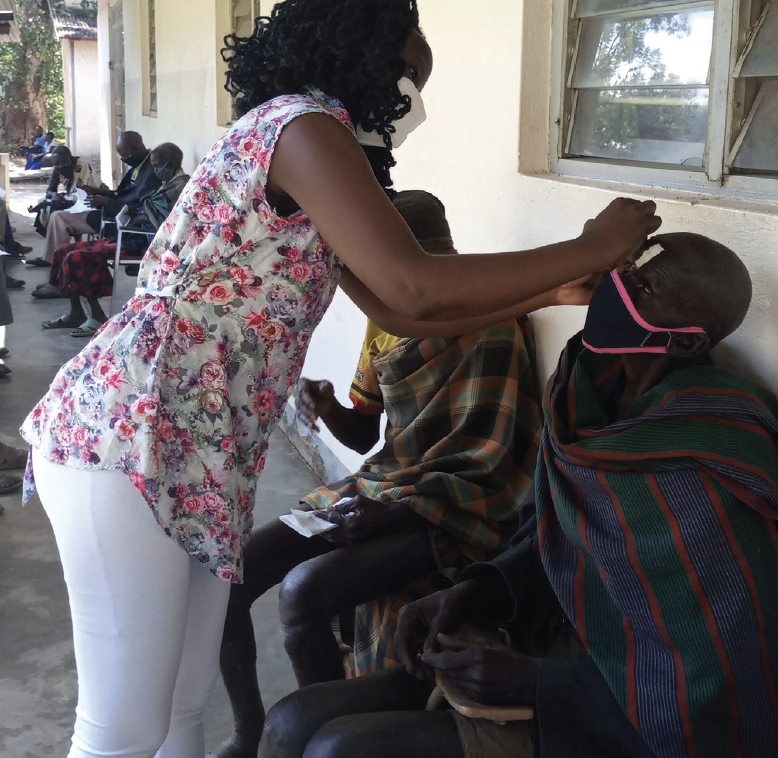Gladys Atto, MB chB, Mmed Ophth, Msc
Uganda

I work in Moroto, one of the nine districts of Karamoja subregion, Uganda, which has about 1.2 million people. I am the only ophthalmologist at the regional referral hospital and the only one in the subregion.
About the Subregion
Karamoja subregion is in the northeastern part of Uganda. The area is semiarid—usually very dry and windy. The population is primarily nomadic, and most people depend on their animals for their livelihood. The literacy rate is low, and the poverty level is the highest in the country.
Karamoja is frequently represented as an exceptionally backward region that is disconnected from the rest of Uganda in both cultural and economic terms. It is also one of the subregions in Uganda that is still endemic for trachoma.
When I arrived in Karamoja in 2018, there was no ophthalmologist living or working in the subregion, so the availability of eye surgery was sporadic and depended upon when an ophthalmologist could visit. The backlog of patients needing care was therefore high.
Delivering Care
There are many potential patients in the subregion. The hospital, however, is not overwhelmed with people seeking eye care services. This is because of the poor health-seeking behavior of the community—many still prefer traditional medicine. On a routine surgical day (3 days per week), I operate on about 10 patients. Because few patients come to the hospital, I collaborate with Sightsavers to deliver health care where it’s needed in the form of community outreach (Figure).

Figure. Dr. Atto examines a patient during a community outreach trip.
The organization sponsors monthly surgical outreach missions to the people living in the nine districts of the subregion. Cataract surgery is the main surgery performed on these trips, and cataract is the leading cause of blindness here.
My colleagues and I can perform up to 20 surgeries per day during these missions. Even if these patients were referred to the regional referral hospital for surgery, most would not be able to come because many of the districts are located more than 100 km away. Transportation is costly, and the terrain is difficult.
Challenges
Professional development. Working alone is not ideal for growing as a professional and developing skills. I don’t have the opportunity to learn new skills from senior surgeons. I must either work with what I already know or learn skills and techniques using online resources and through trial and error. It’s one of the biggest challenges I face.
Twice, I have had to refer patients 500 km away to the Mengo hospital eye clinic in Kampala to access a retina surgeon after a dropped nucleus during cataract surgery.
Scope of work. Because the regional referral hospital is in a remote area, it is difficult for the hospital to retain specialists in other areas of medicine. This means that I carry other workloads in addition to my duties as the head of the hospital’s ophthalmology department and as the regional ophthalmologist. For example, I oversee the hospital’s research ethics committee, I was responsible for chairing the committee that developed the hospital’s client charter, and I am currently involved in the development of the hospital’s 5-year strategic plan. Additionally, I supervise the lower health facilities that refer patients to the hospital; this entails compiling data on the eye conditions being seen and ensuring that no unnecessary referrals are being made.
Human resources. There are only two training centers for graduate ophthalmologists in Uganda—one in Makerere and the other in Mbarara. Because these centers also train international students, the number of Ugandan ophthalmologists graduating per year can be as low as five from each university. The lack of ophthalmologists is a big problem here, but I’m optimistic. I think things will change gradually.
Progress Over 3 Years
I have been working in Karamoja for 3 years, and I am happy to report progress in that time. When I first arrived, many community members feared eye surgery and believed that any operation on the eye would involve its removal. If a patient sought out eye care, the only treatment they would accept was drops. As I mentioned previously, I currently perform up to 10 surgeries in 1 day. I think this improvement is primarily due to the outreach missions I’ve organized with Sightsavers.
The patients operated on during these trips become champions for eye care. They share their knowledge and experiences with their peers, which I think is an effective way of quelling myths around eye removal and creating awareness about eye health services offered.
The Road Ahead
Sightsavers is currently training another ophthalmologist to work in the subregion. This will greatly boost the human resources for eye health. The health system in Uganda allows only two ophthalmologists to work at the level of a regional referral hospital in each region, and each regional hospital is supposed to cover a population of 2 million people. This is way below the four ophthalmologists per million population recommended by the World Health Organization. With this kind of policy, I don’t think much will change in how eye care—and health care in general—is delivered in Uganda, especially at the governmental level.
Unless adjustments in this policy are made, tangible changes in eye care will continue being made only through individual advocacy efforts.
I am working on a few project proposals to increase funding for the lower health facilities that refer patients to the regional hospital. With greater funds, these facilities could become small-scale, fully equipped and staffed surgery centers. An ophthalmologist could travel to these facilities to see patients and perform surgery on a regular basis. This could allow for much more efficient and cost-effective delivery of eye care services to people living in remote areas of Karamoja, and it would relieve ophthalmologists from having to haul equipment and other resources with them during outreach trips.
The Uganda Ophthalmology Society is also advocating for this kind of change to the lower health facilities.
Conclusion
I would be lying if I said this work is easy. It is a struggle to balance my work and personal life. One of the best pieces of advice I have been given is to remember that I cannot do everything in a day, and that that is okay.
When it is time to go home, I spend time with my family, which allows me to go back to work in the morning ready to take on the day. I have also gotten better at asking for help when it is needed—whether it is calling another regional ophthalmologist to go on an outreach trip in my stead or another staff member to assist with prepping the patients for surgery. I’ve learned that, although I am the only ophthalmologist in my subregion, I don’t always have to do everything on my own.


